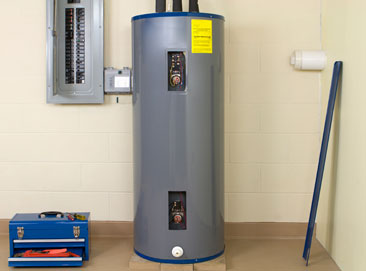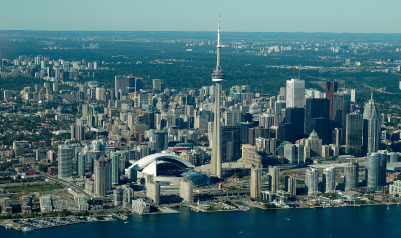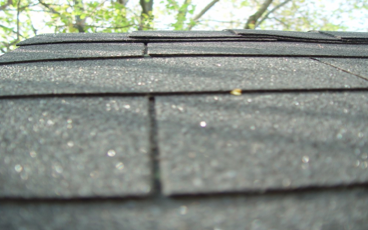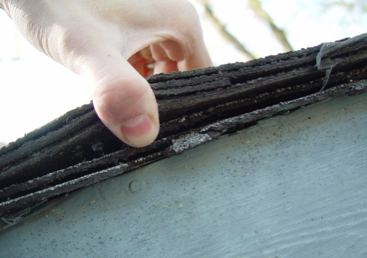The Roof over Your Head: What is up with that?
Posted: August 23, 2012 Filed under: ECONOMY, Home Imrovements Leave a commentNorth America wide, the standard asphalt shingle roof is still the most common roof surface in most areas. If the roof surface is asphalt shingle and the house is 15 years old, it should be no surprise that the roof surface is at or near the end of its life cycle (unless of course the surface has been replaced already).
Clay tile, slate, and concrete tile all last much longer however these are much less common in homes in the 15-year range and have their own peculiarities.
Signs of Newer Asphalt Shingles
Well-installed newer shingles will demonstrate the characteristics below:
- Shingles lie flat, no shadows visible from the ground
- Space between tabs is uniform and tight
- No evidence of a layer underneath (manufacturer warranty is voided if installed over the old shingles)
- Granular aggregate material is intact
This image shows shingles that are in near perfect condition. Note that there is; no wear of granular, no waves in the surface, no layer underneath and no curling etc.
This is another view of the same rooftop. Note how, at this vantage, we can see that these shingles at the ridge are flat and there is no evidence of lifting or curling – this demonstrates almost no wear and tear.
This image shows a roof that is quite old – probably in the 25+ years range. In reality it should have been replaced five or ten years ago but this is not uncommon. If you look close up and straight on, you can see the shingle wear. Signs of wear include:
- Missing granular material shows extensive wear
- Moss growth indicates the shingles are in a shaded area
- The edges of the shingle are worn
- The edges are brittle
- If you bend a corner of the shingle, it breaks right off (a home inspector may test bend a few shingles to help determine the relative age)
This image shows a home inspector lifting the edges of the roof to investigate the lifecycle of the roof. The inspector in this example finds that there are multiple layers. It looks like six or seven layers but it is actually two layers. The term ‘layer’ is a little confusing because it could mean:
- How many times the roof has been re-surfaced without stripping the previous surface
- The number of shingle thicknesses in a single installation.
It is important to understand the concept that a shingle installation has multiple thicknesses of shingles, usually two or three deep. If a home inspector determines that a roof surface is near the end of its life cycle (or even if its not) the client may want to know how many layers of shingles are on the roof because it will make a difference in the overall cost of resurfacing the roof. A home inspector will then be able to determine this by the layers – NOT the thicknesses.
Article generously provided by the lovely folks at Pillar to Post www.pillartopost-northyork.com 416-749-7678
Is there ever a bad time to invest in a rental property?
Posted: May 22, 2012 Filed under: ECONOMY, VARIOUS Leave a commentRecord low interest rates coupled with an overly extended bull market for Canadian residential real estate has some investors questioning the validity of investing in a rental property.
Current economic indicators support these fears: mortgage rates scheduled to rise, a global economy not yet out of the recessionary trenches, residential real estate prices in Canada that have clearly outpaced increases in general earnings over the last decade.
From 1992 to 2011 the average sale price for a home in Toronto increased from $214,971 to $465,412
This all paints a compelling picture supporting the hesitation some investors have when dealing with rental properties. But is this hesitation legitimate? Is there ever really a good or bad time to get into the real estate rental market? The answer is yes, and also no; it all depends on your current financial situation.
If the Toronto residential market is used as a barometer we can see that residential real estate has treated us quite well over the past 20 years. During the period from 1992 to 2011 the average sale price for a home in Toronto increased from $214,971 to $465,412 according to the Toronto Real Estate Board (TREB).
Read more Provided by Personal Finance
Acquisition Vs. Ownership
Posted: April 3, 2012 Filed under: ECONOMY | Tags: real estate 1 Comment We walk onto a car lot, and the first vehicle to which we gravitate is the most attractive, the most powerful, the biggest, or the most luxurious. We set out to buy new household appliances, and the ones that catch our eye are the shiniest, the biggest, or the ones with the most gadgets. The same draw applies to our purchase of new shoes, new cell phones, new computers, and so on. It is understandable, then, that most home buyers look first at the most attractive home, with the amenities that appeal to us, rather than the practical, logical choice.
We walk onto a car lot, and the first vehicle to which we gravitate is the most attractive, the most powerful, the biggest, or the most luxurious. We set out to buy new household appliances, and the ones that catch our eye are the shiniest, the biggest, or the ones with the most gadgets. The same draw applies to our purchase of new shoes, new cell phones, new computers, and so on. It is understandable, then, that most home buyers look first at the most attractive home, with the amenities that appeal to us, rather than the practical, logical choice.
Neuroscientist Antonio Damasio suggests that we, indeed, are living an illusion of conscious choice, since our subconscious directs our actions first, and the emotions stem from our subconscious. In other words, for the most part, we make emotional decisions and then, perhaps, choose to justify them with a logical argument.
But emotional choice when buying a home may be the wrong approach, in spite of the urge to justify it by saying to ourselves, “I am going to be living here for many years, so I want something that I thoroughly enjoy.”
Yes, it is true that if we don’t like something, we will find fault with it regardless of its practical value. Think of taxes! Without them we would be denied many of our social pleasures, but there are very few of us that look for ways to pay more tax.
Emotion is often equated with irrationality. Unfairly, I might add. Logic can be irrational, too. The most secure home is the eight-by-eight isolation cell in a prison, with guaranteed meals, no repairs, and a perpetual “roof over your head.” No one rationally would choose such accommodations.
Home buying requires a balance of emotion and logic. One should look at buying a home much like operating or purchasing a business, balancing the need for something a person enjoys with something that is economically viable. You may love large spiral staircases, but if you are approaching elder years, consider that, in a few years, those beautiful stairs may be a curse, as you attempt to climb the expanse dozens of times each day. Features that appeal to you now may be your nemesis later.
Most prospective homeowners see only the aesthetics, even though they know that they should focus more on practicality.
An energy-efficient home may save thousands of dollars in heating and cooling costs each year, but large, airy windows, a huge basement, hardwood floors, and an expansive yard (with no natural vegetation to block summer heat or winter winds) offers more beauty. A large great room design is “sexy,” but the din of four kids playing in the same room in which you are trying to watch a show, work on the computer, or prepare a meal, may be stressful. Deep, luxurious carpet tugs at the emotions, but may be hard (and expensive) to clean, or difficult to maintain with tons of traffic. A sizeable home with a huge lot in a desirable community may say, “I’ve arrived,” but may also shout “big property tax bill.”
The litany of concerns about making emotional decisions should not deter you, however, from using your emotions to make a buying decision. Although many of us spend more waking hours at work than in our home, we want those precious hours at home to be enjoyable. Being able to say, “I am living in the most efficient house on the block” is of little comfort if the aesthetics are so Spartan that we would rather be at work!
Home buying requires many of the skills that a successful entrepreneur employs. He/she looks at the balance between capital cost and long-term operating costs when purchasing for the business. The capable businessperson evaluates the benefits of short-term versus long-term. Yet, unlike the calculations of a pure capitalist, a homebuyer must also be ready – even eager – to say, “Perhaps I really don’t need this feature,” or, “this item is not practical, but I deserve to treat myself well, and, since I want it, I’m going to let my heart, rather than my head make the choice!”
Toronto Housing Value Great for Buyers and Sellers
Posted: August 9, 2010 Filed under: ECONOMY | Tags: homes for sale toronto, Living in Toronto, MLS Toronto, Remax, Remax Toronto, selling Toronto real estate, toronto homes, toronto real estate, toronto realty Leave a commentValue has little to do with price. Media reports that “Toronto’s house values have skyrocketed” could as easily be seen as a positive indication of the significance of the city as an indication that price has risen.
While the media consistently ranks Toronto, Vancouver, Calgary and Edmonton among Canada’s most pricey housing markets, it fails to add the corollary that those markets lead the way in price because they are the areas that have the most to offer in terms of home ownership, convenience and lifestyle.
While no reporter or commentator would suggest that a Lada could be compared favourably to a Lexus in any other category other than purchase price, the most popular criticisms of Toronto’s real estate market versus other locations across Canada involve little more than a comparison of that price difference.
Real value is derived from price measured against benefit. Commercial value, and, in particular, real estate value is based on market dynamics and competitive pricing, and has little relationship to personal value.
Often slammed sarcastically as “the centre of the universe” by other Canadian communities, Toronto, in fact, has earned the reputation as the centre of the Canadian universe. That reputation derives from the immense benefits that Toronto offers to its residents, and to newcomers.
One of the contributors to rising home prices is rising demand, fueled, in large part, by the influx of people from across Canada, and the in-migration (and immigration) of people from other nations. While Canada holds front-runner status among western democratic nations for ratios of immigrants, Toronto is a real Canadian leader in attracting people from all corners of the country and globe. Do those people yearn to live here because it is an average city, or because it draws people like a magnet with its diversity of opportunity – employment, economic, social, educational, athletic and cultural?
As a westerner, I am proud of my rural, pioneer-like roots, and of the opportunities within my own region of the country. Our housing prices are among the lowest in Canada. Yet, if I am asked for an honest opinion, as to the value of housing here versus Toronto (not price), I must confess that there is no fair comparison.
In recent years, Toronto and southern Ontario have experienced an economic challenge that has seen their relative strength of influence across Canada diminish. Economic strength in Alberta and British Columbia has impacted on the Ontario position in Canada. Yet, Toronto still offers the best long-term potential, with its location among a host of influential cities, communities and regions. So, relative to Canada`s western cities, Toronto`s real estate market has waned. But, when considering the advantages of home ownership in this city, the prospects of newcomers to the city and upward mobility of locals, and the variety of housing stock available, this market still has great value, in spite of increasing prices.
In fact, Torontonians should take pride in its rankings as a city with a “skyrocketing value of housing.” So long as value means worth, rather than solely being based on price, Toronto should encourage the national media to promote the city as a valuable place in which to live.
Frontage Costs for Sewers Add to House Costs
Posted: August 9, 2010 Filed under: ECONOMY 5 CommentsIn many municipalities across Canada, the cost of extending sewer/water services from a main line to a new, subdivided or unserviced lot is the responsibility of the landowner or developer. Particularly, in rural communities where businesses wish to construct a facility that is not able to be served by the existing water line, those businesses often pay the full cost of new water services infrastructure, minus any provincial or federal government contributions.
In 1999, Toronto reconsidered its policies on reimbursement for extension of water services to unserviced lots, in order to bring it in line with the practices of nearby communities. This change in policy is often unnoticed by homebuyers, until the developer levies the charge against the cost that he has incurred, or the city seeks to recover a portion of those costs. The costs can be quite significant!
Sewer line costs are calculated on the basis of the length of the line, or a per-meter basis. In recent years, those costs have increased by more than 280%. Where a prospective buyer of a new home is considering a new development community, it is imperative that he inquires about all costs, including any one-time or ongoing levies.
While the city of Toronto reimburses new water services clients a portion of the construction costs, those fees are less than 50% of the actual construction costs.
One of the ways to mitigate the buyer’s frontage costs is to look for homes on lots that run lengthwise into the property, rather than across the property face. Vertical construction such as this will reduce the lot width demand, and, in turn, reduce water services charges. Even where the developer has absorbed the costs of infrastructure into the purchase price, the narrower lot should result in a lower cost for a lot of the same square footage but wider frontage.
Perhaps the most effective way to ensure that you are not absorbing more than your share of the cost of development for your home site subdivision is to use the services of a realtor. The experience of a professional realtor, much like the expertise of a lawyer or doctor, is the best return on investment that you can make, when making the largest purchase of your life.










